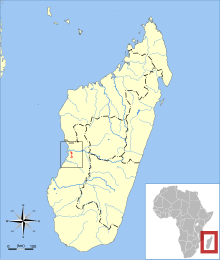Hypogeomys antimena
| Malagasy giant rat Temporal range: Recent |
|
|---|---|
 |
|
| Scientific classification | |
| Kingdom: | Animalia |
| Phylum: | Chordata |
| Class: | Mammalia |
| Order: | Rodentia |
| Family: | Nesomyidae |
| Subfamily: | Nesomyinae |
| Genus: | Hypogeomys |
| Species: | H. antimena |
| Binomial name | |
|
Hypogeomys antimena A. Grandidier , 1869 |
|
 |
|
| Malagasy giant rat range | |
The Malagasy giant rat (Hypogeomys antimena), also known as the votsotsa or votsovotsa, is a nesomyid rodent found only in the Menabe region of Madagascar. It is an endangered species due to habitat loss, slow reproduction, and limited range (20 square kilometres north of Morondava, between the rivers Tomitsy and Tsiribihina) Pairs are monogamous and females bear only one or two young per year. It is the only extant species in the genus Hypogeomys; another species, Hypogeomys australis, is known from subfossil remains a few thousand years old.
Malagasy giant rats have an appearance somewhat similar to rabbits, though maintaining many rat-like features especially in the face. Males and females both grow to roughly rabbit-size, around 1.2 kg (2.6 lb) and 33 cm (13 in), though with an additional 20–25 cm (8–10 in) of dark tail. They have a coarse coat which varies from gray to brown to reddish, darkening around the head and fading to white on the belly. They also have prominent, pointed ears and long, muscular back legs, used for jumping to avoid predators. They can leap almost 3 ft (91 cm) in the air, for which reason they are sometimes called giant jumping rats.
The male Malagasy giant rat reaches sexual maturity within one year, but will not mate until they reach 1.5 to two years. The female Malagasy giant rat reaches sexual maturity in two years. These rats are one of the few rodent species to practice sexual monogamy. Once mated, a pair will stay together until one of them dies. On the death of a mate, females tend to remain in the burrow until a new male is found. While males usually wait for a new mate as well, they do occasionally move to live with a widowed female. Females give birth to a single offspring after a gestation of 102–138 days (number observed in captivity) once or twice during the mating season, which coincides with the Madagascar rainy season from December to April. The young are raised by both parents, remaining in the family burrow for the first 4–6 weeks, then increasingly exploring and foraging outside. Young males stay with the family unit for one year before achieving sexual maturity and leaving to find their own burrow. Females do not mature for 2 years and remain with their parents for the extra year. Males are extremely protective of their young. They are known to increase their own predation risk to follow or defend their offspring.
...
Wikipedia

